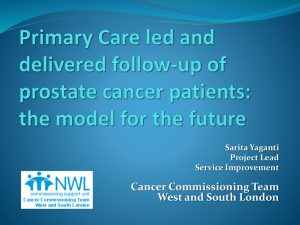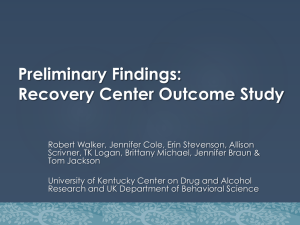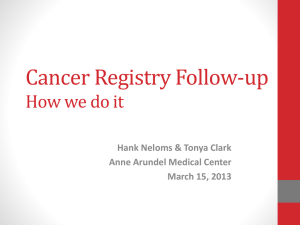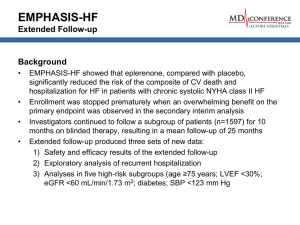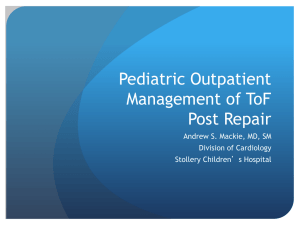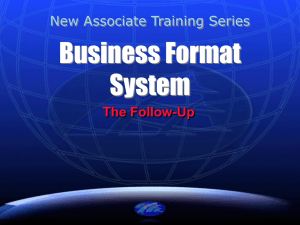Workshop 3 slide presentation - Person
advertisement
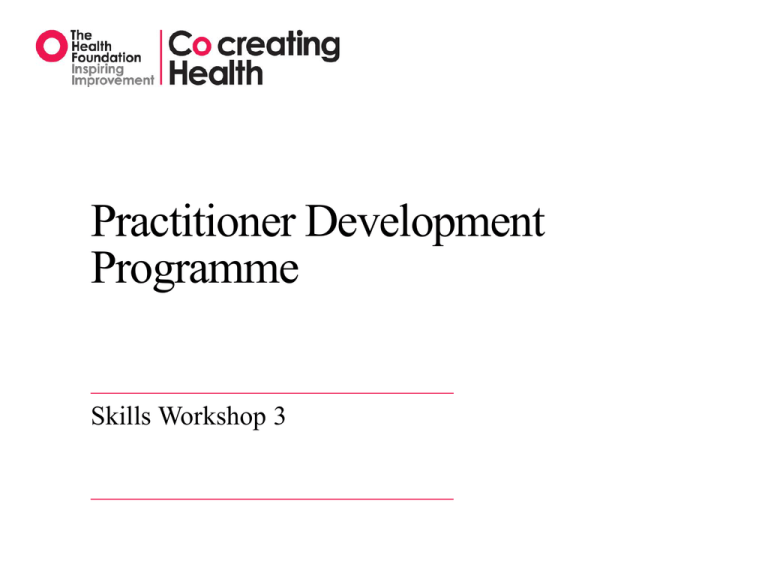
Practitioner Development Programme Skills Workshop 3 Welcome and Introductions • • • • Tutors All in group Name and area of work House keeping; -Manage self -Toilets - All teach all learn -Fire alarm & exits -Refreshments -Mobile phones Successes & Challenges • Share your experiences from last workshop • Skills, patients, systems • Debrief Aims Skills Workshop 3 During this workshop you will have the opportunity to explore the skills which support you to; • • • • • • • • Support collaborative goal setting & action planning Support the patient to review how things went Share success Consider what got in the way – barriers Consider how to move forward – problem solve Share your information & expertise Explore how you will proactively follow up Identify the support you need to progress You will also have the opportunity to consider how your team and services work and how these processes impact your ability to successfully support patients to self manage and identify ideas you have to overcome barriers Programme aim – review Safe, effective, timely, person centred, equitable and efficient The nature of the interaction created by the structures, processes and behaviours that exist within the system Achieving improvement by changing relationships between people & health services Patients, clients groups, service users, carers, families and communities Both the people who work in and deliver care services and the wider system 5 The CCH Integrated Model ©The Health Foundation 6 The Co-creating Health Integrated model ©The Health Foundation 7 The CCH Integrated Skills Model Exploration E Agenda setting Goal setting & Action Planning Planning Goal follow - up Problem solving ©The Health Foundation 8 Health behaviour modelling Biological Emotions / Thoughts Social / Behavioural 9 Skills list •Reflection/Empathy •Support autonomy & choice •Explore agenda/priority •Double-sided reflection •Explore agenda: clarify boundaries •Explore ambivalence •Invite goals •Explore beliefs about selfmanagement •Ask before advise •Explore importance 0-10 •Problem solving •Explore confidence 0-10 •Action planning •Effective Follow-up Inviting goals - review Once you have explored importance and confidence support the patient to consider an area that they wish to work on and help them set a goal and action plan around this. This is the first step in supporting them to translate intention into action. Remember to support their autonomy and choice and be mindful of their level of activation. You can take a long term view. Your patient is living with a LTC and you have time to support small incremental progress which will build confidence and skills. • Is there an area that you would like to work on? • How might you go about that? • How important is it to you? • How confident do you feel ? Progress to an action plan Once the goal has been identified you will need to support the patient to break this down into small achievable steps which will be made up of the actions required to make progress towards achievement of the goal. Do not assume that you know better than the patient ‘what is realistic for them’. Remember they need to build their confidence and problem solving skills, share their success and have support to find ways to overcome their challenges. Goal setting, action planning and follow-up is a continuous loop of planned activity resulting in continual development of the patients confidence and skills to self manage. If we neglect any of these elements the cycle will break down. The highest area of risk for this to happen is ‘follow-up’. Current service design and resource constraints mitigate against effective follow and it is an historically weak area for the NHS. We now know that Patients who receive follow up within two weeks of goal setting and action planning make the best SM progress. We must listen to our patients and together develop and embed successful ways to provide and deliver meaningful follow-up within the constraints of today’s healthcare economy. Goal setting to action planning • • • • • • • • What is the goal that you are working towards? What do you need to do to achieve the goal? Which ‘bit’ would you like to work on How important is it to you? (0-10) What things might get in your way/ stop you doing it? How might you overcome these? When will you do it? How often will you do it? • If you visualise yourself doing this, how confident do you feel that you can achieve this? (0-10). Explore using techniques from last workshop. What makes it 6 rather than 5.....What would take it up to 7.............. • Patient’s are most likely to successfully undertake the action and achieve their goal if their confidence is 7 or greater. Making the plan robust How often do we have an intention to do something and then it is never quite the right time or there are too many obstacles? In order to make the plan robust and give greatest potential for success we should support patients to set SMART goals (really a SMART action plan) and utilise the problem solving cycle skills that they develop in the parallel skills programme. • • • • • S M A R T Specific Measurable Achievable Realistic Time based What you will do? How much...how often? How confident are you that you can do it? How confident are you that you will do it? When will you do it? As you go through this process patients often revise their goal/action. Support their autonomy to do this however you should both ensure that by the end of the consultation that there is an agreed goal and plan that you will follow-up The problem solving cycle A key component of successful goal setting and action planning is to consider the potential barriers and challenges that might ‘get in the way’ and to identify and explore potential solutions to overcome these. The problem solving cycle is a useful tool for achieving this and is one of the skills that your patients will learn in the SMP. Remember that we are supporting our patients to become more confident problem solvers. We need to be their coach and support them to find solutions that will work for them in the context of their lives. We should resist the urge to suggest solutions and should provide ample opportunity for the patient to identify these themselves. Get lots of ideas Evidence shows us that it is better to generate a range of possible solutions rather than trying to find the ‘one perfect answer’. Use your exploration skills to support the patient to generate a range of possibilities. They should select one to try and then re-check confidence Ask the patient to reflect back to you what they are going to do. In addition to confirming that you have a shared understanding there is a value to the patient hearing themselves say what their goal is and how they are going to achieve it. Continue to address barriers until confidence is at least 7 If strategy they have selected is not effective support them to try another of the ideas they generated The unrealistic goal The goal should belong to the patient. If confidence remains below 7 ensure that you have provided sufficient opportunity to explore barriers. Other reasons for confidence being low may be that you have contributed your own ideas to the goal and it is therefore not truly owned by the patient. If appropriate recheck importance scale. This element may have been missed earlier in the process. If a patient has set what appears to be an unrealistic goal assess if there is any ‘risk’. If not support their autonomy and choice. If you consider that there is some ‘risk’ use collaborative language to share your concerns and negotiate. Do not make assumptions about what is ‘realistic for the individual or judgements about their ability to achieve their plan. Summary: Action plan From goal agree the action plan (SMART) Check confidence [7+] If less than 7 re-examine barriers Do not suggest goal unrealistic Support patient’s autonomy & choice Agree follow-up process [Make sure the patient has selected to the goal and it is important to them] Interactive exercise Goal setting and action planning exercise: can be done as one large group or in small groups of 3 with a full group debrief of one example • • • • Consider a goal that you wish to achieve Use the techniques discussed to explore the goal, set an action plan and agree follow up You should ensure you have a SMART goal Debrief Effective goal setting is an area that clinicians may find more challenging as they often have less experience and fear that it may take a significant amount of time Efficiency comes with experience, however you may also need to consider which role(s) within your team are best equipped to undertake goal setting both with regard to skills and time. You may also wish to consider other approaches such as group goal setting Sharing knowledge & ideas Within ‘the partnership’ there is knowledge and expertise on both sides. You will have information, ideas and experience which may be beneficial for the patient. It is appropriate to share these, however you should first give the patient space and opportunity to explore their own thoughts and ideas and then check that you have permission to share yours. This is respectful, sends a cue to the patient and allows them to focus on the information you are giving. • • • • I have some ideas about that, would you like to hear them... Other patients have told me what works for them, would it be helpful to share them.... I have some information, would you like to see it..... There is a support group, would you like me to give you the information about it..... Ask before advise – is a powerful collaborative tool that can be used in any part of the consultation Follow-up Living with a long term condition is hard work. Self management requires skills, knowledge and effort. Patients need to feel supported, be able to share their success, have support to overcome their challenges and have access to the appropriate information and services. This support comes from a variety of sources including; Health and social care, family and friends, peer support groups. This is a continuous process and we must ensure that our systems are designed to successfully deliver this. Follow-up is an core element of successful self management and self management support, it is our responsibility to provide it. Follow-up • Follow up ideally within 14 days – especially important for people at the beginning of their journey of activation • Explore how patient got on.... How did it go? • What went well? • What was more challenging? • Use positive language • Do not add judgement or opinion with regard to challenges • Use problem solving cycle to address barriers Crucially progress to next goal/action plan to maintain momentum – continuous loop Examples Simple and effective ways of building systems and processes for rapid Follow up include: • • • e-mails or texts can be typed up at the end of a consultation and set up to send automatically a couple of weeks later administrators as well as clinical staff can make follow-up phone calls, also helping them feel more a part of the team general practice can follow up on progress after a hospital appointment when the patient sees the GP or practice nurse about their condition or some other ailment. 24 Models for follow-up; Interactive exercise Free think • • • • • • What systems do you have in place to provide follow up? What follow up support do your patients want? What works well? What are the challenges/barriers? What ideas do we have to overcome these? How might we make these happen? Examples of Activating interventions •Access to health coaches •Longer appointments •Group goal setting and follow-up •Text support between appointments •Peer support networks Experiential practice • Consider the skills we have covered and decide what you would like to try • Most useful to select an area for which you attach high importance and have low confidence • Safe environment to try things in a different way and seeing what happens Action plan & next steps The skill I am going to work on; The patient focused activity I am going to work on; The process I am going to work on; Experiential practice • Consider the skills we have covered and decide what you would like to try • Most useful to select an area for which you attach high importance and have low confidence • Safe environment to try things in a different way and seeing what happens Where do we go from here? • • • • • • • Share SMP data Share ideas for systems development Agree team goal and action plan (SMART) Identify continued support required: skills, patient activity, systems Action Learning Sets Memory aids Systems support tools



